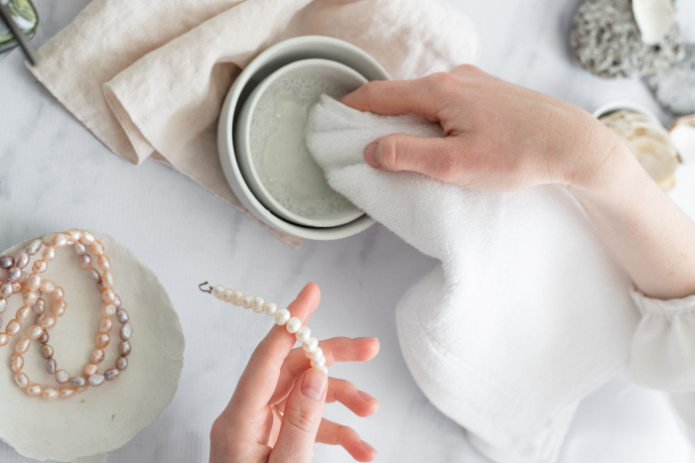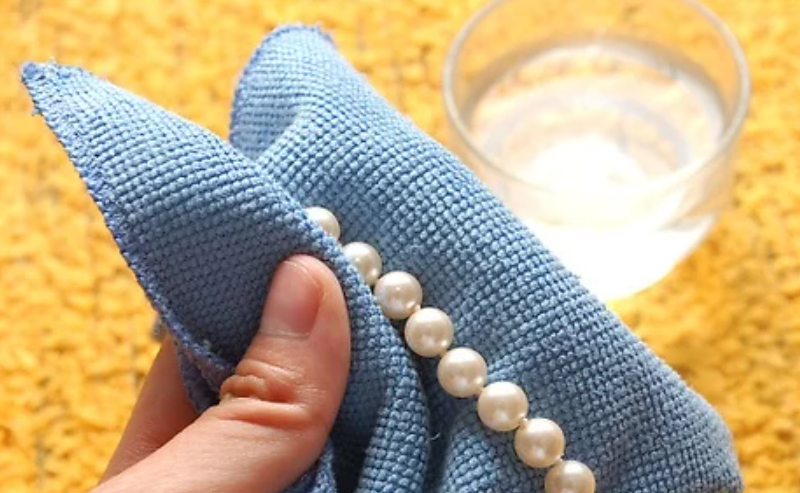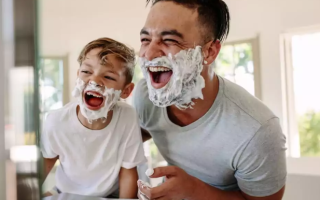Pearls, nature’s luminous gifts from the sea, have enchanted humanity for millennia with their ethereal glow and understated elegance.
Born within the soft tissue of shelled mollusks, pearls epitomize organic beauty, each one a unique masterpiece shaped by the rhythm of the oceans. This beauty, however, is delicate and transient.
Unlike gemstones mined from the earth, pearls are organic and porous. Their luster, once lost, can never be truly regained.
As tokens of luxury, sentiment, and timelessness, pearls deserve meticulous care to maintain their pristine allure. Just as we care for other treasured possessions, pearl jewelry requires specific and gentle maintenance.
In this article, we will delve into the vital steps necessary to keep your pearls shining bright. In the process, ensuring they remain as captivating as the day they were first strung.
Understanding Pearls: Their Delicacy and Value
Pearls have been treasured for centuries for their aesthetic appeal and the intricate process through which they’re formed. However, you should first grasp their unique structure and inherent value to care for them properly.
Composition of Pearls: A Combination of Calcium Carbonate and Organic Material
At the heart of a pearl’s formation is a tiny irritant or particle that becomes embedded within a living mollusk.
To soothe this irritant, the mollusk secretes layers of a nacre around the foreign object. Over time, these layers accumulate, giving birth to the lustrous gem we know as a pearl.
This nacre is primarily composed of calcium carbonate in the form of aragonite plates. These plates are held together by an organic protein called conchiolin. This organic-inorganic matrix renders the pearl its iridescent glow.
But while this composition gifts pearls with their beauty, it also makes them susceptible to various elements, including acids, humidity, and harsh chemicals.
How Pearls Differ from Other Gemstones in Terms of Care Requirements
1. Organic Origin: Unlike sapphires, diamonds, or rubies, which are mined from the Earth’s depths, pearls are organic gems produced by living organisms. This means they can be more affected by environmental factors and are generally softer than other gemstones.
2. Porosity: Pearls are porous. This means they can easily absorb substances like perfumes, oils, or even sweat. Over time, these substances can dull the pearl’s sheen or even harm its structure.
3. Sensitivity to Chemicals: Due to their organic nature, pearls can react adversely to chemicals found in cosmetics, hairsprays, and cleaning products. Even natural acids present in our sweat can affect their luster over time.
4. Physical Delicacy: While diamonds are renowned for their hardness and resilience, pearls are delicate and can easily scratch or chip when they come into contact with hard surfaces or other jewelry pieces.
Understanding these differences is crucial. While you might use an ultrasonic cleaner for your diamond ring or immerse your ruby necklace in soapy water, doing so with pearl jewelry could lead to irreversible damage.
The key to preserving the elegance of pearls lies in recognizing their unique characteristics and ensuring that care routines are tailored to safeguard their delicate nature.
Why Regular Cleaning of Pearl Jewelry is Essential
With their radiant glow and soft sheen, pearls require more than occasional admiration.
Regular maintenance and cleaning are crucial for preserving these delicate gems’ beauty and longevity. Delving deeper, we uncover the primary reasons behind the necessity of regular cleaning.
Preservation of the Pearl’s Luster and Color
A pearl’s charm lies in its unique luster — that soft, iridescent sheen that seems to emanate from within. However, with daily wear or even intermittent usage, pearls can accumulate a layer of grime, dirt, or cosmetics, dulling their natural radiance.
- Cosmetic Residue: Pearls can easily become coated with residues from make-up or skincare products. Powders, creams, and even the natural oils from our skin can settle onto the surface of a pearl, diminishing its brilliance.
- Environmental Factors: Simply exposing pearls to air can lead to minor discolorations or a loss of sheen over time. The presence of pollutants or even ambient moisture can influence the color and luster of pearls.
Regular cleaning ensures these external agents are gently removed, maintaining the pearl’s natural color and inherent glow.
Prevention of Damage from Everyday Pollutants and Body Oils
Beyond the preservation of beauty, regular cleaning plays a pivotal role in safeguarding the very structure of pearls.
- Body Oils and Sweat: The human body naturally secretes oils and sweat. While these might seem harmless, they can be slightly acidic. Given the porous nature of pearls, prolonged exposure to these acids can weaken the nacre, making the pearls more vulnerable to chipping or cracking.
- Chemical Exposures: Hairsprays, perfumes, and even some cleaning agents can have chemicals that might adversely react with the pearl’s surface. Over time, these can dull the pearl and lead to surface pitting or degradation.
- Prevention of String Wear: Regular cleaning isn’t just about the pearls if your pearls are strung on a necklace or bracelet. Dirt and grime can wear down the string or the knots between each pearl. By keeping them clean, you’re also ensuring the longevity of the entire piece.
- Value Retention: Maintaining their condition is paramount for those who view pearls as an investment. Regular cleaning ensures that the pearls remain in top-notch condition, preserving both their aesthetic and monetary value.
How To Clean Pearl Jewelry: Step-by-step Guide
Caring for your pearl jewelry requires no intricate tools or esoteric knowledge. With simple household items and a gentle touch, you can restore the sparkle to your beloved pearls. Thereby ensuring they continue to shine with their characteristic allure. Below is a comprehensive guide to aid you in this delicate endeavor.
Gathering the Right Supplies
Before commencing, it’s crucial to gather all the necessary supplies. This ensures a smooth and efficient cleaning process without unnecessary interruptions.
- Soft, lint-free cloth: This will be your primary tool. The cloth should be soft to ensure that no scratches are imparted onto the delicate surface of the pearls. Lint-free is vital to prevent any small fibers from sticking to the pearls.
- Mild soap: Opt for a gentle, unscented, and devoid of harsh chemicals or abrasives. Baby soap or a mild detergent can be ideal choices.
- Warm water: Ensure the water is warm and not hot, as extreme temperatures can damage pearls.
- Small bowl: A vessel in which you’ll prepare the soapy mixture for cleaning.
The Cleaning Process
With all supplies at hand, proceed with the following steps:
- Preparing a Soapy Water Mixture: Mix a few drops of the mild soap with warm water in the small bowl. Stir until it’s well combined and a light soapy solution is formed.
- Dipping the Cloth into the Solution and Wringing it Out: Submerge the lint-free cloth into the soapy mixture, ensuring it’s well soaked. Wring it out so that the cloth is damp and not dripping.
- Gently Wiping Each Pearl: With gentle and tender motions, wipe each pearl with a damp cloth. Avoid rigorous rubbing; the goal is to remove dirt or residue without applying excessive pressure.
- Ensuring No Water Gets into the Drill Holes of Pearls: If your pearls are drilled, be cautious to prevent any water from entering the holes. Accumulated water inside can weaken the pearl from within or damage the stringing material.
Rinsing and Drying
Post-cleaning is vital to rinse any soap residues and dry the pearls appropriately.
- Using a Cloth Dampened with Fresh Water to Rinse off any Soap Residue: Dip a fresh lint-free cloth into clean, warm water, wring it out, and gently wipe the pearls to remove any lingering soap.
- Laying the Pearl Jewelry on a Soft Towel: Place the pearl jewelry on a soft towel once rinsed. Ensure that individual pearls are spread out to prevent them from scratching against each other.
- Allowing the Jewelry to Air-dry Completely: Natural air-drying is crucial. Avoid using hairdryers or placing them under direct sunlight, as these can harm the pearls. Let them sit until completely dry, especially if strung, ensuring the string is also dry.
Cleaning pearl jewelry combines meticulous attention and gentle care. By following these steps, you can ensure your pearls maintain their natural luster, safeguarding their beauty for years.
What NOT to Do When Cleaning Pearl Jewelry
While understanding how to clean pearl jewelry is vital, knowing what to avoid is equally crucial. With their organic nature and delicate composition, pearls can be susceptible to certain cleaning methods and substances.
In this section, we’ll delve into practices and products you should avoid, ensuring the longevity and luster of your treasured pearl pieces.
1. Avoid Ultrasonic Cleaners
Ultrasonic cleaners are popular tools used to clean various types of jewelry by producing high-frequency sound waves. While they might be effective for certain gemstones and metals, they’re decidedly not suitable for pearls. Here’s why:
Vibration Damage: The vibrations generated by ultrasonic cleaners can cause the nacre of the pearl to chip or even separate.
Chemical Exposure: Ultrasonic solutions often contain chemicals that can be too harsh for pearls, leading to discoloration or a dulling of their sheen.
2. Steer Clear of Acidic or Ammonia-based Cleaners
The chemical composition of pearls makes them vulnerable to strong chemicals:
Acidic Reactions: Pearls can react adversely to acidic substances, breaking their calcium carbonate structure. This can not only dull the pearl’s shine but might also compromise its integrity.
Ammonia Effects: Ammonia-based cleaners, often used for cleaning diamonds or other gemstones, can strip the pearl of its natural luster and can cause surface degradation.
3. Don’t Submerge the Jewelry in Water
While it might be tempting to give your pearl jewelry a thorough soak, especially if it appears particularly grimy, this practice comes with risks:
Weakening the String: If your pearls are strung, prolonged immersion can weaken the string or the knots between each pearl, increasing the risk of breakage.
Water Entrapment: Drilled pearls might trap water within the drill holes, leading to the string’s potential internal damage or rotting.
4. Avoid Direct Exposure to Heat
Heat can be detrimental to pearls in various ways:
Dehydration: Pearls contain a small amount of water within their structure. Direct exposure to heat sources, like hairdryers or sunlight, can dehydrate them, leading to brittleness and a loss of luster.
Thermal Shock: Sudden temperature changes can result in the cracking or splitting of pearls.

Routine Maintenance for Pearl Jewelry
Pearls, akin to living treasures, thrive with consistent care. Beyond the act of cleaning, the way you wear, store, and routinely inspect your pearls can have a pronounced impact on their longevity and beauty. Let’s explore the essential aspects of daily maintenance that every pearl owner should internalize.
Wearing Pearls After Applying Cosmetics or Perfumes
Pearls are often the finishing touch to an outfit, the shimmering accents that add elegance to any ensemble. But when should you put them on? Here’s a guideline:
Chemical Exposure: Cosmetics, including lotions, makeup, and even the natural oils on our skin, contain chemicals that can affect the luster and health of a pearl. Perfumes, in particular, often have alcohol and other solvents that can be harmful.
The Golden Rule: Always apply makeup, lotion, and perfume before donning your pearl jewelry. Give the products some time to settle and be absorbed. This way, the pearls come into contact with your skin and not directly with the cosmetics or perfumes.
Storing Pearls Separately from Other Jewelry Items
Storage plays a pivotal role in the preservation of pearls. Their softness makes them vulnerable to scratches, dings, or other damage.
Tender Surfaces: Unlike harder gemstones like diamonds or rubies, pearls can be easily scratched or marred.
Do’s:
- Store pearls in a soft pouch or a separate compartment in your jewelry box to prevent them from scratching against other jewels.
- Lay strand necklaces flat to keep the string from stretching.
- Keep pearls in a moderately humid environment. Pearls draw moisture from the air, and overly dry conditions can cause them to crack.
Don’ts:
- Don’t store pearls in airtight containers or plastic bags. These can cause dehydration.
- Avoid storing pearls in direct sunlight or excessively hot environments.
- Keep pearls away from other hard gemstones to prevent scratching.
Periodically Checking for Loose Settings or Damaged Clasps
Pearl jewelry, especially earrings or rings, often have settings that hold the pearls in place. Necklaces and bracelets have clasps that can wear down over time.
Wear and Tear: Even with the best care, the components of jewelry can deteriorate or become loose. A loose pearl in a setting can result in losing the gem or further damage.
Routine Inspection: At least once a year (or more frequently for regularly worn items), inspect your pearl jewelry. Ensure that pearls are securely set and that clasps function smoothly.
If you notice any loose pearls or malfunctioning clasps, visit a jeweler for repairs. This proactive approach can prevent potential losses and prolong the life of your cherished pieces.
Professional Cleaning
Pearls, nature’s delicate gifts, have charmed humanity for eons with their ethereal beauty. Their intrinsic allure calls for exceptional care, and sometimes, despite our best efforts, at-home cleaning might not suffice. In such scenarios, entrusting them to professionals becomes paramount.
When and Why You Might Consider Having Pearls Professionally Cleaned
Pearls are unlike any other gemstone; their organic nature makes them both unique and vulnerable. While routine home maintenance keeps them in good shape, certain situations necessitate the finesse only a professional can offer.
1. Discoloration or Dullness: Despite regular cleaning, you might notice your pearls losing their inherent sheen or turning slightly yellow over time. This discoloration can arise from prolonged exposure to harsh lights, chemicals, or simply age. Professionals can reverse or minimize this discoloration, rejuvenating your jewelry.
2. Accumulation of Stubborn Grime: Sometimes, dirt might embed itself deep within the pearl’s surface or in areas hard to reach. At-home cleaning might not be potent enough to handle such grime, and vigorous scrubbing could cause damage.
3. Before Special Events: If you’re planning to don your pearl jewelry for a significant event, professional cleaning ensures they shine their brightest.
4. Restoration: Antique or inherited pearls stored away for years may need more than surface cleaning. Professionals can revitalize such heirlooms without compromising their integrity.
Benefits of Professional Services:
Safety: Professionals have the right tools and knowledge to clean without causing harm.
Comprehensive Care: Besides cleaning, professionals inspect for other issues like loose settings or damaged clasps.
Longevity: Regular professional cleaning ensures that pearls remain in top-notch condition for generations.
How Professionals Clean Pearls Without Damaging Them
Professionals combine age-old wisdom with modern techniques to ensure your pearls are treated with the respect they deserve.
1. Specialized Cleaning Solutions: Not available on general market shelves, these solutions are formulated exclusively for pearls. They cleanse without eroding the nacre, ensuring the pearls remain undamaged and lustrous.
2. Ultrasonic Cleaning (with Caution): While pearls generally shouldn’t be cleaned with ultrasonic machines, some professionals may use them sparingly and with extreme caution for certain types of pearl jewelry, ensuring no harm comes to the gem.
3. Gentle Steam Cleaning: Professionals use controlled steam cleaning techniques to gently remove accumulated dirt without using harsh chemicals or vigorous scrubbing.
4. Manual Inspection: Every pearl is individually inspected before and after the cleaning process. This attention to detail ensures that no pearl is overlooked, and each gets its bespoke care.
5. Expert Polishing: Using soft, lint-free cloths and specialized polishing agents, professionals can enhance the pearl’s natural glow, making them look as captivating as they were when first acquired.
Advantages of Expertise and Professional Handling:
Precision: Years of experience mean professionals can discern the exact type and degree of care each pearl needs.
Restoration Skills: Beyond cleaning, professionals can restore and restore pearls, ensuring their longevity.
Advice and Guidance: Post-cleaning, many professionals offer guidance on storing and wearing pearls, ensuring they remain beautiful for longer.
While our care goes a long way, professionals add that extra layer of security and brilliance, ensuring our pearls remain timeless in their allure.
What to pay attention to when wearing pearl jewelry
While mesmerizing in their allure, Pearls demand a heightened sense of awareness when worn.
Their organic origin makes them susceptible to factors that might not affect other gemstones. Maintaining the pristine condition of your pearls is not only about how you clean them but also how you wear them.
Here are some crucial considerations to keep in mind when adorning yourself with these lustrous gems.
Cosmetics, Perfumes, and Pearls: Sequence Matters
1. Apply Before You Adorn: Always put on make-up, perfume, and hairspray before you put on your pearl jewelry. Chemicals present in cosmetics can degrade the pearl’s luster over time.
2. Wait a While: After applying cosmetics and fragrances, wait a few minutes for them to settle and dry before wearing your pearls. This minimizes direct contact with potentially harmful substances.
3. Skin Oils and Lotions: Just as with cosmetics, apply any moisturizers or skin lotions and let them fully absorb before putting on your pearls.
4. Hand Sanitizers: Given the current global emphasis on hand hygiene, be cautious when using hand sanitizers, especially if wearing a pearl ring or bracelet. The high alcohol content can be detrimental to pearls.
5. Avoiding Direct Sprays: If you need a perfume touch-up while wearing pearls, ensure you do not spray directly onto or around the pearls.
Conclusion
Pearl jewelry, with its timeless elegance and ethereal beauty, is a testament to nature’s artistry. But with such beauty comes the responsibility of meticulous care.
As we’ve navigated through the ins and outs of cleaning pearls, it’s evident that these radiant gems require a delicate touch and specific care methods, distinguishing them from many other pieces in your jewelry collection.
Regular maintenance is about more than preserving the pearls’ visual appeal. It’s about honoring their unique composition, ensuring longevity, and safeguarding their inherent charm.
Whether you opt for gentle at-home cleaning or seek the expertise of professionals, the end goal remains consistent: to preserve the iridescent glow and unparalleled allure of these natural wonders.
In a constantly changing world, pearls remain a symbol of grace and sophistication.
By committing to their regular cleaning and maintenance, you’re not just taking care of a piece of jewelry but cherishing a legacy.
Let the luster of your pearls reflect not just their inherent beauty but also the care and love with which they are treated. Here’s to many more years of your pearls shining brilliantly and captivating hearts!



